
The Broadway Limited was a passenger train operated by the Pennsylvania Railroad (PRR) between New York City and Chicago. It operated from 1912 to 1995. It was the Pennsylvania's premier train, competing directly with the New York Central Railroad's 20th Century Limited. The Broadway Limited continued operating after the formation of Penn Central (PC) in February 1968, one of the few long-distance trains to do so. PC conveyed the train to Amtrak in 1971, who operated it until 1995. The train's name referred not to Broadway in Manhattan, but rather to the "broad way" of PRR's four-track right-of-way along the majority of its route.

The Capitol Limited was an American passenger train run by the Baltimore and Ohio Railroad, originally between New York City and Grand Central Station in Chicago, Illinois, via Union Station, Washington, D.C., Baltimore and Pittsburgh. For almost 48 years, it was the B&O's flagship passenger train, noted for personalized service and innovation. At the time of its discontinuation on May 1, 1971, when Amtrak took over most rail passenger service in the U.S., the Capitol Limited operated between Washington and Chicago.

Martin Luther King Jr. Plaza is the main passenger rail and intercity bus station of Toledo, Ohio.

The National Limited was the premier train of the Baltimore and Ohio Railroad (B&O) on its route between Jersey City, New Jersey and St. Louis, Missouri, with major station stops in Washington, D.C., and Cincinnati, Ohio. It operated from 1925 to 1971. For much of its life it offered exclusive all-Pullman service, and it was the first long-distance train to be entirely air-conditioned. The National Limited was one of many trains discontinued when Amtrak began operations on May 1, 1971. Amtrak revived the name for another New York–St. Louis service which did not use the B&O route.

The Union Depot is a former train station, located at 637 E. Michigan Avenue in Lansing, Michigan. It was listed on the National Register of Historic Places in 1995. Despite the union name, Grand Trunk Western trains stopped at a different station in Lansing 1.5 miles away.
The Cincinnati Limited was a named train of the Pennsylvania Railroad; the train traveled from New York City's Pennsylvania Station to the Cincinnati Union Terminal. It was a rival to New York Central's Ohio State Limited. The Cincinnati Limited carried connecting sleeping cars to the Louisville and Nashville Railroad's Cincinnati to New Orleans Pan American. By the mid-1950s, the sleeper extension on L&N lines ended at Memphis instead of New Orleans.
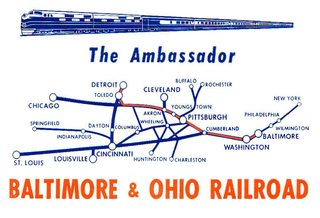
The Ambassador was a named train of the Baltimore and Ohio Railroad (B&O) on its route between Baltimore, Maryland and Detroit, Michigan with major station stops in Washington, D.C. and Pittsburgh, Pennsylvania and Toledo, Ohio. Inaugurated in 1930, the Ambassador was discontinued in 1964.
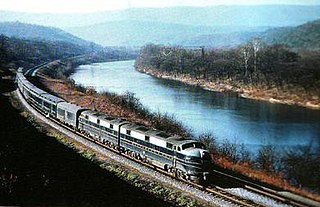
The Shenandoah was an American named passenger train of the Baltimore and Ohio Railroad (B&O), one of four daily B&O trains operating between Jersey City, New Jersey and Grand Central Station in Chicago, Illinois, via Washington, D.C. and Pittsburgh, Pennsylvania from the 1930s to the 1950s. Other B&O trains of that period on the route were the Capitol Limited, Columbian, and the Washington–Chicago Express. An alternate branch originated in Detroit and met with the Chicago part of the train at Deshler, Ohio, south of Toledo.
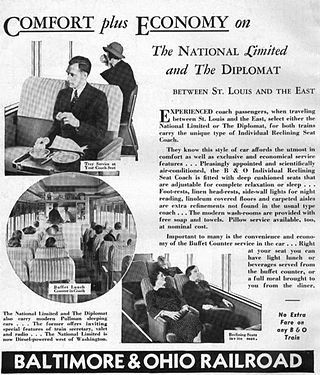
The Diplomat was a named passenger train of the Baltimore and Ohio Railroad (B&O) during the 1930s–1950s connecting New York City and St. Louis, Missouri, via Washington, D.C. Other B&O trains on the route during that period were the premier National Limited and the workhorse Metropolitan Special. The train was inaugurated in August 1930 after several changes to trains along the St. Louis Route. After World War II, the Diplomat operated as Train No. 3 westbound, and No. 4 eastbound. It was timed to provide connections to several western railroads that terminated in St. Louis, including the Frisco, the Santa Fe, Cotton Belt and Missouri Pacific, among others.

Mercury was the name used by the New York Central Railroad for a family of daytime streamliner passenger trains operating between midwestern cities. The Mercury train sets were designed by the noted industrial designer Henry Dreyfuss, and are considered a prime example of Streamline Moderne design. The success of the Mercury led to Dreyfuss getting the commission for the 1938 redesign of the NYC's flagship, the 20th Century Limited, one of the most famous trains in the United States of America.
The Night Express was an American named train of the Baltimore and Ohio Railroad (B&O) on its route between Detroit, Michigan, and Louisville, Kentucky, with major station stops in Toledo, Ohio, and Cincinnati. The service was numbered Train 57 southbound and Train 58 northbound. The numbers 57/58 operated on the Detroit - Cincinnati line as early as 1921. The service was provided in conjunction with the Pere Marquette Railroad from Detroit to Toledo and with the Louisville and Nashville from Cincinnati to Louisville with connections to New Orleans.
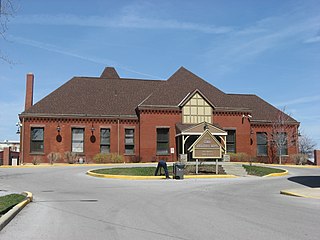
Lima is a historic former train station in Lima, Ohio, United States. Built for the Pennsylvania Railroad in 1887, it is a brick Queen Anne structure that rests on a sandstone foundation. The Lima station is located 261 miles west of Pennsylvania Station in Pittsburgh, PA, 705 miles west of Pennsylvania Station in New York, NY, and 228 miles east of Chicago Union Station in Chicago, IL along the former Pennsylvania Railroad's mainline between New York City and Chicago. Lima station was formerly served by the Pennsylvania Railroad's Pennsylvania Limited and by its flagship Broadway Limited daily passenger trains between New York City and Chicago in its later years.

Hamilton (HMN) is a former railroad station on Amtrak's Cardinal route between Chicago and New York City. The station in Hamilton, Ohio, was served by the Cardinal from August 1980 until October 31, 2005, when it was discontinued as a stop. Constructed by the Cincinnati, Hamilton & Dayton Railroad, the building is still owned by CSX though currently unused. It sits at the junction of the Indianapolis Subdivision with the Toledo Subdivision both part of the CSX Louisville Division, and headed south of the station the line is known as the Cincinnati Terminal Subdivision, also due to a directional running agreement most CSX and Norfolk Southern freight trains will use the Cincinnati Terminal Subdivision headed north to New River Junction in New Miami, Ohio where Norfolk Southern trains diverge to the left on the New Castle District, and CSX trains diverge to the right on the Toledo Subdivision. Now headed south towards Cincinnati most CSX and Norfolk Southern trains will diverge at the Butler St. Interlocker just blocks before the station heading south on the New Castle District. The Pennsylvania Railroad, followed by the Penn Central used another station, one on Maple Avenue, until 1971.
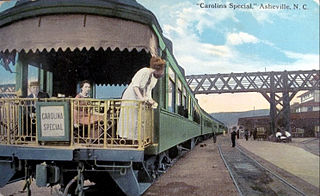
The Carolina Special was a passenger train operated by the Southern Railway between Cincinnati, Ohio and the Carolinas. It operated from 1911 to 1968. It was the last passenger train to use the route of the Charleston and Hamburg Railroad, which, as the South Carolina Canal and Railroad Company, began operation in December 1830, as one of the oldest railroads in the United States, and, by 1833, operated a 136-mile (219 km) line to Hamburg, South Carolina, on the Savannah River, the country's longest at that time. All Southern Railway Pullman service to Charleston rode over that historic, if bucolic, route from Branchville to the port city.

The Strata-Domes were a fleet of five streamlined dome cars operated by the Baltimore and Ohio Railroad ("B&O"). The term referred both to a pair of dome cars constructed by Pullman-Standard and three Budd Company domes the B&O acquired from the Chesapeake and Ohio Railway ("C&O"). They were the first dome cars operated in the Eastern United States, following on the success of the Chicago, Burlington and Quincy Railroad's "Vista-Domes" in the west. The cars entered service in 1949 and were all out of regular service by 1981. Several have been preserved.
The Southland was a night train between Chicago, Illinois and different points in western and eastern Florida from 1915 to 1957. In early years it was called the New Southland. It was distinctive among Midwest to Florida trains as its western branch was the only all-season mid-20th-century long-distance train passing from Georgia to Florida bypassing the usual passenger train hub of Jacksonville Union Station. The main operator was the Louisville and Nashville Railroad, and pooling partners were the Pennsylvania Railroad, the Atlantic Coast Line Railroad and to lesser extent, the Wabash Railroad and the Florida East Coast Railway. For southeast bound -but not northwest bound- trips to Norfolk, Virginia, some coaches in 1946 diverged at Cincinnati along a Norfolk and Western Railway route. Northwest bound, travelers could switch trains at Cincinnati for heading towards Chicago.
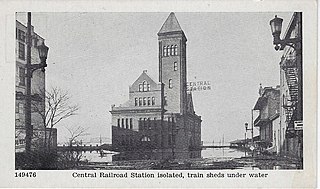
Central Station was a major station in Louisville, Kentucky. Built in the Richardsonian Romanesque style, it served several railroad companies until the mid-20th century. It was situated at North 7th Street and West River Road, near the Ohio River waterfront, and it was also known as the 7th Street Depot.
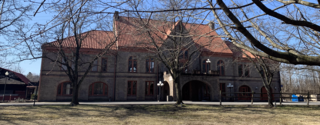
Youngstown is a former passenger railroad station in Youngstown, Ohio. The station is on the ex Baltimore and Ohio Railroad, and was a B&O passenger station for most of the twentieth century. The station was built in 1905 and operated as a passenger station until 1971, when the B&O yielded passenger train service to Amtrak. It was later a passenger station for Amtrak through the 1990s and early 2000s.

Canton station, or Canton–Akron station, is a former train station in Canton, Ohio.
Springfield Big Four Depot was a Springfield, Ohio passenger train station of the Cleveland, Cincinnati, Chicago and St. Louis Railway, commonly referred to as the 'Big Four Railroad.' Construction on the station began on November 22, 1909 and it opened for service in 1911, The brick structure was located at 202 Washington Street and Spring Street, east of the Big Four's previous station on the south side of Washington Street.

















